Abstract
The molecular charge transfer reactions of quinine (Q) with 2,3-dichloro-5,6-dicyano-p-benzoquinone (DDQ) and 7,7,8,8-tetracyanoquinodimethane (TCNQ) as a π-acceptor to form charge transfer (CT) complexes have been studied. The CT complexes were characterized by infrared spectra, NMR, mass spectrometry, conductometry and spectrometry. The Q-DDQ and Q-TCNQ charge transfer complexes were monitored at 480 and 843 nm, respectively. The results confirm the formation of CT complexes. The molar ratio of Q:DDQ and Q: TCNQ assessed using Job’s method was 1:1, which agrees with the results obtained by the Benesi-Hildebrand equation. The stability of the formed CT complexes was assessed by measuring different spectroscopic parameters such as oscillator strength, transition dipole moment, ionization potential, the energy of CT complex, resonance energy, dissociation energy and standard free energy change. The DFT geometry optimization of quinine, DDQ and TCNQ, its charge transfer complex, and UV theoretical vs. experimental comparative study were carried out. The theoretical and experimental results agreed. DFT/B3LYP/6-311++G(d,p) level of theory was used for the investigation of charge transfer between quinine as electron donor and (DDQ and TNCQ) as electron acceptors. The geometric structures, orbital energies, HOMO, LUMO and energy gaps were determined. The transition energies of the charge transfer complexes were computed using the TD-DFT/B3LYP/6-311++G(d,p) level of theory. The computed parameters were comparable to the experimental parameters, and the computational results aided in the analysis of the data.
Keywords:
Quinine; DDQ; TCNQ; charge transfer complex; spectroscopy; density functional theory (DFT) 1. Introduction
Charge-transfer (CT) complexes are formed as a result of the interaction of a donor with an acceptor through the formation of hydrogen bonds, which was first introduced by Mulliken and coworkers [1,2]. This type of interaction (donor-acceptor) has a worth attention for chemical reactions including addition, substitution and condensation [3]. It also has been reported that CT complexes can formed by the reactions of σ- and π-electron acceptors with different donors such as amines, crown ethers, polysulfur bases and oxygen-nitrogen mixed bases [4,5,6,7,8]. The photometric methods used to study the interactions of CT complexes are usually simple and feasible due to the fast formation of the complexes.
As it is well known that, most of the CT complexes having broad applications in chemical analysis including quantitative drug estimation by formation of donor-acceptor complexes [9,10,11]. CT complexes having excellent electrical and electronic conductivities [12,13,14,15] and can be applied to explore drug-drug interaction, drug-acceptor linking properties [16,17]. In addition, interaction of these types of CT complexes can be used to understand action mechanism of photo-catalysts. Due to the above properties of CT complexes it has been attracted considerable attention to researcher for further development of synthesizing new CT complexes. It should be noted that, determination of above properties using CT complexes are considered a simpler, cheaper and more effective analysis tool compared to other reported methods [18,19]. Because of the simple preparation method of CT complexes and large number of applications in biological/material fields we aimed to conduct this study.
Here, we report, in-suite synthesis of quinine-CT complexes with DDQ and TCNQ, characterized using different spectroscopic techniques (IR and NMR) and the conductometry (Figure 1). The stability of the quinine with DDQ and TCNQ complex in the solution is characterized using the Benesi-Hildebrand equation to determine the formation constant and molar extinction coefficient. In addition, the stoichiometry of the Q-DDQ and Q-TCNQ is assessed using Job’s method. Different spectroscopic parameters are determined including oscillator strength, dipole moment, ionization potential, complex energy, resonance energy, dissociation energy, and standard free energy. Furthermore, a theoretical study of Q-DDQ and Q-TCNQ is presented based on density functional theory (DFT).
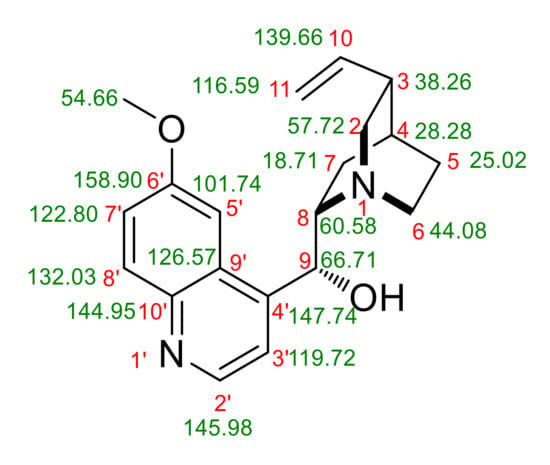
Figure 1.
Chemical structure of quinine. The red numbers represent the atom numbering while the green numbers represent the 13C NMR chemical shift values.
2. Materials and Methods
2.1. Reagents and Materials
All chemicals used are of a high purity grade. The pure analytical reagent quinine sulfate was obtained from Sigma. Deionized water was used in all experiments. 2,3-Dichloro-5, 6-dicyano-p-benzoquinone (DDQ) and 7,7,8,8-tetracyanoquinodimethane (TCNQ) were purchased from Sigma-Aldrich (Steinheim, Germany). Acetonitrile was obtained from the Winlab Laboratory, Leicester, UK.
2.2. Instruments
A double-beam, ultraviolet-visible spectrophotometer (Shimadzu, Kyoto 1800, Japan) with 1-cm quartz cells was used. Melting points were determined on a Gallenkamp melting point apparatus. Infrared (IR) spectra were recorded as KBr disks using the Perkin Elmer FT-IR Spectrum BX apparatus. NMR spectra were scanned in DMSO-d6 on a Brucker NMR spectrometer operating at 500 MHz for 1H and 125 MHz for 13C. Chemical shifts are expressed in δ-values (ppm) relative to TMS as an internal standard. Coupling constants (J) are expressed in Hz. D2O was added to confirm the exchangeable protons. An Orion conductometer (Beverly, MA 01915-6199, USA) was used to measure the conductance of quinine and its complexes. The mass analyzer (Agilent 6410 QqQ) connected to an electrospray ionization (ESI) source was operated in both positive and negative ion modes for ion generation and analysis.
2.3. Synthesis Procedure: Synthesis of Q-DDQ Charge-Transfer Complex
Quinine (0.33 g, 1 mmol) dissolved in dry acetonitrile (25 mL) was added to a solution of 2,3-dichloro-5,6-dicyano-p-benzoquinone (0.23 g, 1 mmol) in dry acetonitrile (25 mL) and the reaction mixture was stirred at room temperature for 3 h. The obtained reddish solid product was filtered off, washed with acetonitrile, then dried in vacuo to give 0.43 g of red substance. Yield 76%, mp 188 °C. 1H NMR (acetone-d6) δ: 1.50 (1H, t, J = 10.0 Hz, H4), 1.91 (1H, dt, J = 10.0, 3.0, Hz, H5a), 2.56 (1H, sept., J = 1.5 Hz, H5b), 2.08-2.10 (2H, m, H7a,b), 2.77 (1H, q, J = 5 Hz, H3), 3.18 (1H, ddd, J = 10, 5, 1.5 Hz, H6a), 3.27 (1H, dt, J = 11.5, 3.5 Hz, H6b), 3.58 (1H, t, J = 9 Hz, H2a), 3.68 (1H, t, J = 6 Hz, H2b), 4.05 (1H, t, J = 10 Hz, H8), 4.17 (3H, s OCH3), 5.02 (1H, d, J = 7.5 Hz, H11), 5.14 (1H, J = 12.5 Hz, H11), 5.85 (1H, ddd, J = 12.5, 7, 5 Hz, H10), 6.94 (1H, br s OH), 6.55 (1H, dd, J = 6.5, 1.5 H9), 7.79 (1H, dd, J = 9, 2 Hz, H7ʹ), 7.96 (1H, d, J = 4.0 Hz, H3′), 8.09 (1H, m, H5ʹ), 8.32 (1H, dd, J = 9.5, 4.7 Hz, H8ʹ), 9.10 (1H, dd, J = 4.0, 1.0 Hz, H2ʹ) ppm. 13C NMR (acetone-d6) δ: 174.32 (DDQ), 172.02 (DDQ), 171.09 (DDQ), 161.89 (DDQ), 159.48 (DDQ), 159.45 (6ʹ), 150.86 (4ʹ), 144.66 (2ʹ), 138.95 (10ʹ), 136.24 (10), 129.24 (8ʹ), 126.78 (9ʹ), 119.80 (7ʹ), 116.33 (3ʹ), 113.75 (11), 102.88 (5’), 101.70 (DDQ), 87.82 (DDQ), 65.85 (9), 58.77 (8), 57.68 (2), 53.03 (MeO), 42.71 (6), 40.43 (DDQ), 36.79 (3), 26.67 (4), 23.81 (5), 17.63 (7) ppm. FT-IR (KBr disk) n: 3247 (OH), 2934 (CH2), 2209 (CN), 1697 (C=O), 1562 (C=C), 1427 (C=C), 1246 (C-O), 1019 (C-N), 819 cm−1.
Synthesis of Q-TCNQ charge-transfer complex Quinine (0.33 g, 1 mmol) and 2,2’-(cyclohexa-2,5-diene-1,4-diylidene) dimalononitrile (0.20 g, 1 mmol) were dissolved in dry acetonitrile and the reaction mixture was stirred at 70 °C for 3 h. The obtained greenish solid product was filtered off, washed with acetonitrile, then dried in air to give 0.42 g of red substance. Yield 79 %, mp 137 °C. 1H NMR (acetone-d6) δ: 1.50 (1H, t, J = 10 Hz, H4), 1.91 (1H, dt, J = 10, 2 Hz, H5a), 2.08–2.10 (2H, m H7a,b), 2.56 (1H, sept., J = 1.5 Hz, H5b), 2.08-2.10 (2H, m H7a,b), 2.77 (1H, q, J = 5 Hz, H3), 3.18 (1H, ddd, J = 10.5, 5, 2 Hz, H6a), 3.27 (1H, dt, J = 10.5, 3.5 Hz, H6b), 3.58 (1H, ddd, J = 12.5, 8.5, 7.5 Hz, H2a), 3.68 (1H, ddd, J = 12.5, 8.5, 7.5 Hz, H2b), 4.05 (1H, t, J = 8.5 Hz, H8), 4.17 (3H, s OCH3), 5.02 (1H, d, J = 7.5 Hz, H11), 5.14 (1H, J = 12 Hz, H11), 5.85 (1H, ddd, J = 12, 7, 5 Hz, H10), 6.94 (1H, br s OH), 6.55 (1H, d, J = 3 Hz, H9), 7.79 (1H, dd, J = 6.5, 2 Hz, H7ʹ), 7.96 (1H, d, J = 2 Hz, H3ʹ), 8.10 (1H, d, J = 3 Hz, H5ʹ), 8.32 (1H, d, J = 6.5 Hz, H8ʹ), 9.10 (1H, d, J = 3.2 Hz, H2ʹ) ppm. 13C NMR (acetone-d6) δ: 161.94 (TCNQ), 158.06 (6ʹ), 153.08, (TCNQ), 146.84 (4ʹ), 146.26 (2ʹ), 142.94 (10ʹ), 138.99 (10), 130.66 (8ʹ), 129.45 (TCNQ), 125.82 (TCNQ), 125.78 (9ʹ), 124.66 (TCNQ), 124.02 (TCNQ), 122.42 (7ʹ), 121.11 (TCNQ), 119.15 (3ʹ), 118.07 (TCNQ), 116.19 (11), 114.53 (TCNQ), 102.10 (TCNQ), 102.03 (5ʹ), 65.54 (9), 58.99 (8), 57.17 (2), 52.89 (MeO), 42.69 (6), 40.43 (TCNQ), 36.77 (3), 26.72 (4), 25.48 (TCNQ), 23.84 (5), 17.62 (7) ppm. FT-IR (KBr disk): 3247 (OH), 2929 (CH2), 2179 (CN), 1620 (C=C), 1508 (C=C), 1433 (C=C), 1241 (C-O), 1025 (C-N), 857, 717 cm−1.
2.4. Stoichiometry
The molar ratios of the donor and acceptors were assessed by Job’s method or the continuous variation method [20] and the ratio of the resulting complex was determined by Job’s method. Stock solutions of (1 × 10−3 M) of Q, DDQ and TCNQ were prepared in acetonitrile. Series of ten drug concentrations (1:9, 2:8, 3:7, 4:6, 5:5,... to 9:1) were prepared for Q-DDQ and Q-TCNQ.
2.5. Quantum Chemical Calculations
Computational density functional theory (DFT) was achieved using the B3LYP function and the 6–311++G(d,p) basis set for Quinine, DDQ, and TCNQ and its charge transfer complex. The DFT leads to the perfect ordinary style investigation and geometry optimization of the isolated compounds. Molecular electrostatic potential (MEP) maps were obtained at the same level of theory. Time-dependent DFT calculations were performed in acetonitrile using the default polarizable continuum model. The density functional theory calculations were made using the Gaussian 03 program package [21].
3. Results
3.1. Charge Transfer Complex in Solution
2,3-Dichloro-5,6-dicyano-1,4-benzoquinone and TCNQ are known electron acceptors which undergo radical anion transfer from an electron donor such as amines to form charge transfer complexes. In addition to the nitrogen atom of the quinoline ring, quinine has a tertiary amine of the quinuclidine subunit. We expected the nitrogen atom of the latter to act as the electron donor center rather than the π-deficient aromatic heterocyclic subunit. Nevertheless, the molecular orbitals of quinine were affected by losing one electron and this was noticeable due to the change of the chemical shifts of the 1H NMR bands to down-field. DDQ, a non-aromatic system, underwent one-electron reduction from quinine and yielded DDQ radical anion (DDQ●−) (Scheme 1). The stability of DDQ●− is augmented by the formation of a complex with the quinine radical anion. TCNQ, which is also a non-aromatic system, forms a radical anion in combination with quinine. TCNQ is assumed to behave similar to DDQ and ultimately forms an aromatic ring structure after one-electron abstraction from quinine as depicted in Scheme 1. The TCNQ radical anion was stabilized by the formation of the charge transfer complex with the quinine radical anion.
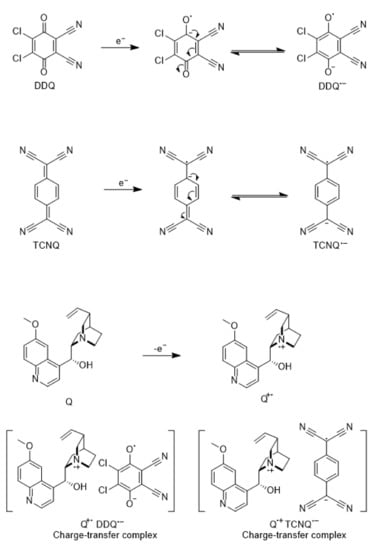
Scheme 1.
The proposed mechanism for the formation of quinine-DDQ and quinine-TCNQ charge-transfer complexes.
3.1.1. Electronic Spectra
The formation of the donor-acceptor Q-DDQ and Q-TCNQ complexes was promoted by the high ionizing power of the polar solvent (acetonitrile) [22], and all measured experimental in solution are carried out in acetonitrile. As shown in Figure 2, the ultraviolet-vis spectra of the proposed complex exhibited maximum absorption spectra at 480 nm and 843 nm, which is related to the formation of the CT complex. In contrast neither the donor (quinine: 230 nm, 280 nm and 334 nm) or acceptors (DDQ or TCNQ) exhibit absorption at 480 or 843 nm, as presented in Figure 2. All spectrophotometric measurements were carried out against blank.
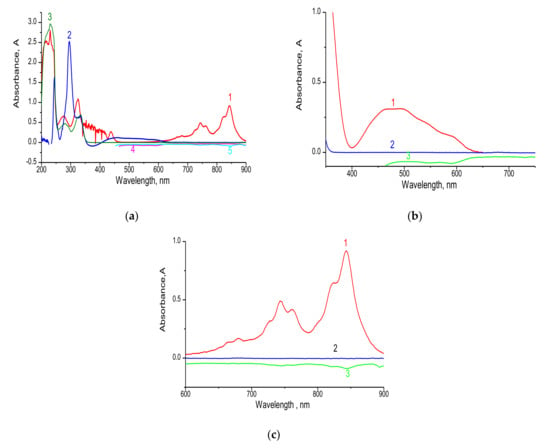
Figure 2.
(a) Absorbance spectrum of (1) Q-TCNQ (2) 400 ppm Q-DDQ and (3) 400 ppm Q, (4) DDQ blank and (5) TCNQ versus blank. (b) Absorption spectrum of (1) 400 ppm of Q-DDQ complex, (2) 400 ppm of donor (quinine), and (3) DDQ versus Blank. (c) Absorption spectrum of (1) 400 ppm of Q-TCNQ complex, (2) 400 ppm of donor (quinine) and (3) TCNQ versus Blank.
3.1.2. Stoichiometry and Formation Constant
Stoichiometry of the complexes was determined graphically by plotting the absorbance (A) of the resulting complex (y-axis) against the molar ratio of the acceptor/donor to complex (x-axis) as indicated by Job’s method. The donor to acceptor ratio was 1:1 in both cases (Figure 3). The association constant of the CT complex was calculated using the modified Benesi- Hildebrand method. It was evaluated at room temperature (25 ± 2 °C) and at the maximum of CT complex in acetonitrile using the following Equation (1) [23]:
where Ca and Cd are the initial concentration of acceptor (DDQ or TCNQ) and donor (quinine); is the absorbance of the complex formed at the , is the molar absorptivity of the complex, and K is the association constant of the complex (L mol−1). When the values (Ca Cd)/A were plotted against (Ca + Cd) a straight line was obtained, from which one may calculate the association constant, correlation coefficient and the molar absorptivity () of the CT complex (Figure 4). The Benesi-Hildebrand data is presented in Table 1. The intercept of the fitting line corresponded to . The association constant is calculated from the slope of the line () and the derived value of . The molar absorptivities were found to be and L mol−1 cm−1 for Q-DDQ and Q-TCNQ, respectively. The association constant of the complex in acetonitrile was found to be and L mol−1 for Q-DDQ and Q-TCNQ, respectively.
(Ca Cd)/A = 1/Kε + (Ca + Cd)/ε
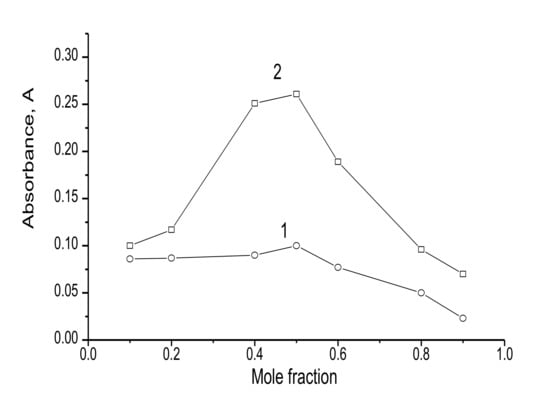
Figure 3.
Molar ratio method (Job’s method) using (1 × 10 −3 M) for (1) Q-DDQ and (2) Q-TCNQ method) using (1 × 10 −3 M) for (1) Q-DDQ and (2) Q-TCNQ.
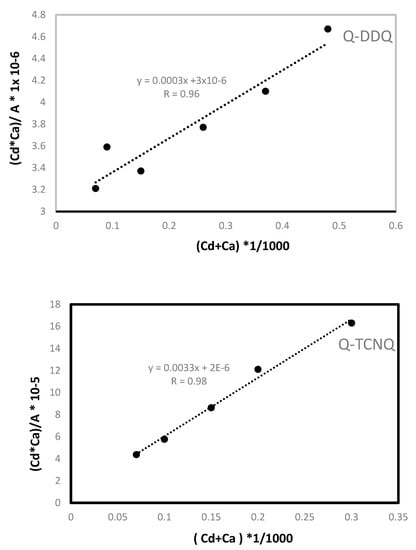
Figure 4.
The 1:1 Benesi-Hildebrand Plot for Q-DDQ and Q-TCNQ CT complexes system. (Ca and Cd: initial concentration of acceptor, and donor, and A: absorbance).

Table 1.
Benesi–Hildebrand data of quinine complex.
3.1.3. Spectroscopic Physical Parameters
The oscillator strength () Equation (2) [7,17], and the transition dipole moment (μ, Debye) Equation (3) [7] of each complex were determined according to the equations:
and
where is the bandwidth at half intensity, is the molar extinction coefficient, and is the wavenumber at the absorbance maximum of the complex. The values of these parameters are shown in Table 2. The relatively high values of (0.989 for Q-DDQ and 0.163 for Q-TCNQ) indicate a high interaction between Q and DDQ or TCNQ, which translates to the high stability of the two complexes. Furthermore, high values were observed for transition dipole moment, 10.09 for Q-DDQ and 5.41 for Q-TCNQ, indicating strong interaction between donor Q and acceptors (DDQ or TCNQ) due to the distribution of charge within the system.

Table 2.
Spectroscopic characteristics of quinine charge transfer complex.
Ionization potential: The ionization potential of the Q donor was assessed based on the energy of the CT complexes with acceptors DDQ and TCNQ using the Aloisi and Pignataro Equation (4) [24]:
where is the wave number in cm−1 related to the CT band formed due to the reaction between Q and the acceptors. The values contributing to the CT complex formation are given in Table 2. The electron donation potential of Q is indicated by its . As the decreases, the electron donation power of Q increases and, consequently, the stability of the CT complex increases. The ionization potentials were found to be 8.91 and 7.57 for Q-DDT and Q-TCNQ, respectively, and thus the stability follows the order: Q-DDQ >Q-TCNQ.
Energy of CT complex: The energy () of the CT complexes was estimated using the Equation (5) below [17]:
where is related to the wavelength of the complexation band. The obtained energy values were 2.56 ev and 1.47 ev for Q-DDQ and Q-TCNQ, respectively.
Resonance energy: The resonance energy () of the CT complexes was assessed using the Briegleb and Czekalla Equation (6) [25]:
where corresponds to the molar absorptivity of the CT complexes. The values are indicated in Table 2. The stability of the CT complexes in the ground state, which contributes to the stability constant of the complex (a ground -state property). It was found that the resonance energies of Q-DDQ and Q-TCNQ are 0.112 ev and 0.194 ev, respectively. The stability of the complex in ground state was in the order Q-TCNQ > Q-DDQ.
Dissociation energy: The dissociation energy () is used to express the nature of the CT complex in the excited state. It was calculated using the Equation (7):
where is the energy of the CT complex, is the ionization potential of the donor and is the electron affinity of the acceptors. The values of were found to be 4.45 ev and 3.3 ev for Q-DDQ and Q-TCNQ, respectively.
Standard free energy: The nature of the CT interaction was indicated by the standard free-energy change values () (8) shown in Table 2. Negative values indicate that the reaction between Q and the acceptors is exothermic. As the values become more negative, the formation constant increases [17]. The standard free-energy change was calculated according to the equation below:
where is the free-energy change of the CT complex (kJ mol−1), is the gas constant (1.987 cal mol−1 K−1), is the absolute temperature in Kelvins, and is the association constant of the CT complex at room temperature. The negative values of free energy indicate a spontaneous reaction between the donor and acceptor. The calculated values of for Q-DDQ and Q-TCNQ were −3.1 × 103 and −4.2 × 103 kJ mol−1, respectively.
3.2. Investigation of Synthesized CT Complex
3.2.1. Infrared
The FTIR spectrum of quinine-DDQ CT complex: The FTIR spectrum of the quinine-DDQ complex is shown in Figure 5. The band attributed to the -OH stretching frequency originally appearing at 3285 cm−1 in the pure sample shifted to 3247 cm−1 in the quinine-DDQ complex. The 38 cm−1 shift in the value of (O-H) band could be attributed to the stretching vibration of a proton attached to the donation site of the donor. In addition, the band located at 2223 cm−1 stretching frequency assigned to the cyano group (C☰N) in free DDQ shifted to 2209 cm−1. The characteristic band of the C=O appeared at 1674 cm−1 in pure DDQ shifted to 1697 cm−1. The band at 1508 cm−1 which is assigned to the aromatic C=C stretching frequency in shifted to 1498 cm−1. The C-O stretch at 1241 cm−1 shifted to 1246 cm−1. Finally, the C-N band previously located at 1095 cm−1 exhibited a slight shift to 1110 cm−1 for the complex. The shift of the IR bands revealed a donor-to- acceptor charge transfer of π–π* interaction.
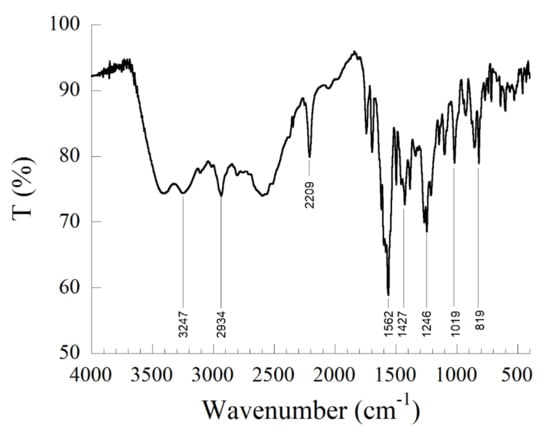
Figure 5.
FTIR spectrum of Q-DDQ.
The FTIR spectrum of quinine-TCNQ CT complex: The FTIR spectra of quinine-TCNQ complex are shown in Figure 6. Comparison of the individual spectrum revealed significant band shifts after complex formation. The quinine OH stretching band previously located at 3285 cm−1 shifted to 3247 cm−1 in the Q-TCNQ complex. The 38cm−1 shift in the value of (O-H) band could be attributed to the stretching vibration of a proton attached to the donation site of the donor. Another significant change is observed for the cyano group (C☰N) which shifted from 2257 to 2179 cm−1. In addition, the band associated with the aromatic C=C stretch shifted from 1429 cm−1 to 1433 cm−1.
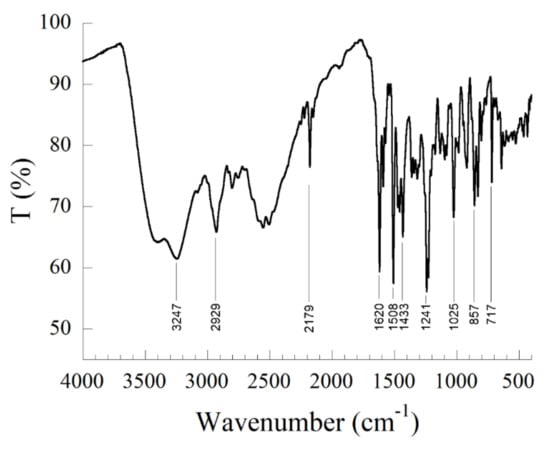
Figure 6.
FTIR spectrum of Q-TCNQ.
In conclusion, comparing the FTIR spectra of free quinine, the electron donor, free DDQ, electron acceptor, and the Q-DDQ complex on one side and the Q-TCNQ complex on the other side has revealed that the IR spectra of the CT complexes exhibit a shift in the wave numbers of some bands as well as the superposition of other bands. It is also noticeable that some bands have become different in shape and intensity. This variation could be an indicative of molecular association leading to the formation of the CT pair. At the molecular level, the CT formation may be initiated by an electron transfer from either the aliphatic nitrogen atom of the quinuclidine subunit or the quinoline subunit in quinine to the electron-deficient DDQ or TCNQ counterpart.
3.2.2. NMR
1H NMR
1H NMR spectroscopy of quinine-DDQ charge transfer complex: A comparison of the 1H NMR results of native quinine and quinine-DDQ charge-transfer state were shown in Table 3 and Figure S1. While the 1H signal attributed to H9 showed an almost identical chemical shift (δ = 6.55 ppm), most of the other signals for Q and the Q-DDQ complex did not counterpart. A deep comparison of the 1H NMR spectrum corresponding to Q and DDQ revealed that the bands can be classified into three categories: (a) Peaks of Q-DDQ complexes showing almost the same chemical shifts as that recorded for quinine. These are H6, H2, and H9 peaks. (b) Peaks are shifted up-field such as the signals of H5a, H7, H3, and H8. (c) Peaks are shifted down-field such as the H4, H5b, OMe, H8, H10, H11, OH, H7′, H3′, H5′, H8′, and H2′. The change in the chemical shift values of the Q-DDQ charge-transfer state compared to that for Q could be attributed to the change of the electron densities of the newly formed complex due to the redistribution of the electrons cloud around the protons.

Table 3.
1H NMR chemical shifts in ppm for quinine and quinine-DDQ, and quinine-TCNQ charge-transfer complexes.
1H NMR spectroscopy of quinine-TCNQ charge transfer complex: The 1H NMR spectrum of the Q-TCNQ CT complex is presented in Figure S2. Table 3 also present a comparison between the chemical shift values of Q-TCNQ charge-transfer complex compared to Q. The 1H NMR spectra of Q-TCNQ and Q-DDQ are similar and the comparison to that for Q revealed that the peaks can also be classified into three main categories: (a) Peaks showing almost the same chemical shifts like the ones belonging to the drug itself. These peaks are H2, H6, and H9. (b) Peaks were shifted up-field such as the 1H signals of H3, H5a, H7, and H8. (c) Peaks were shift down-field such as the 1H signals of H4, H5b, OCH3, H10, H11, OH, H2′, H3′, H5′, H7′, and H8′. The misalignment of Q-TCNQ 1H signals compared to Q signals clearly reveals the formation of the Q-TCNQ CT complex.
13C NMR
13C NMR spectroscopy of the Q-DDQ CT complex. The study of the 13C NMR spectrum of Q-DDQ was performed to confirm the formation of the CT complex (Table 4). The spectrum showed the presence of 28 signals corresponding to the Q 20 signals and the 8 DDQ signals (Table 4 and Figure S3). The spectrum also revealed a mismatch between the 13C signals of the Q fragment in the complex in comparison with the free Q moiety. For instance, the signal corresponding to C4ʹ appears at 147.74 ppm for quinine, but shows up at 150.86 ppm for the complex.

Table 4.
13C NMR chemical shifts in ppm for quinine and quinine-DDQ charge transfer complex.
13CNMR spectroscopy of the Q-TCNQ CT complex. Besides the 1H NMR spectroscopy, we also studied the 13C NMR spectrum of Q-TCNQ to verify the formation of the CT complex. The spectrum confirmed the presence of 32 signals corresponding to the 20 Q signals and the 12 TCNQ signals (Table 5 and Figure S4). The spectrum also revealed a mismatch between the 13C signals of the quinine fragment compared to the free Q moiety. For instance, the C9ʹ signal appearing at 126.57 ppm for Q shifted slightly to 125.78 ppm. The 1H NMR and 13C NMR studies both reveal the formation of Q-TCNQ. The shift in the peak values of the 1H NMR and 13C NMR might be attributed to the intermolecular interaction between the donor and the acceptor leading to the formation of Q-TCNQ CT-complex.

Table 5.
13C chemical shifts in ppm for quinine and quinine-TCNQ charge transfer complex.
Mass Spectrometry
The electrospray ionization (ESI) mass of the CT complexes was evaluated. The resulting masses were used to confirm the composition of the CT complexes. The ESI-MS spectra represented the fragment ion mass spectrum of the complexes [(Q+-DDQ- and Q+-TCNQ-)]. The mass spectra exhibited one molecular ion peak at m/z = 325 in the positive mode and two molecular peaks at m/z 228 and 204 for the DDQ and TCNQ acceptors, respectively, in the negative mode. These results support the formation of Q-DDQ and Q-TCNQ CT complexes.
3.3. Computational Studies
3.3.1. Geometry Optimization
The Quinine structure was optimized in the gas phase using the B3LYP function along with the 6–311++G(d,p) basis set to confirm that the molecule has a minimum energy conformation allowing the acquisition of theoretical UV spectra. A comparison of these theoretical spectra with experimental results is depicted in Figure 7.
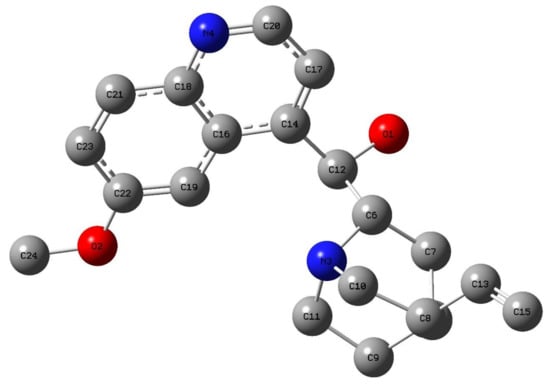
Figure 7.
Optimized geometry of Quinine.
The optimized structure of quinine (Figure 7) shows a rich conformational behavior. The most important degrees of freedom are the two torsional angles, τ1: C17-C14-C12-C6 and τ2: C14-C12-C6-N3, which determine the relative orientation of the quinoline moiety [26]. It should be noted that the methoxy substituent of the quinoline ring is one of the most stable conformations in a cis conformation [27].
A description of the Mulliken charges of quinine, DDQ and TNCQ are shown in Figure 8. The donor Quinine molecule approaches the DDQ and TNCQ acceptor molecules from the nitrogen atom of the quinoline ring. From (Table S1) we can deduce the transferred charge between quinine and (DDQ, TNCQ). Quinine has a tertiary amine of the quinuclidine subunit. As illustrated in Figure 8, the Q-DDQ complex structure is stabilized by two H bonds given by O(31) H-C(18)(2.04 Å) and N(37) H-C(14)(2.17 Å). The same is said for the Q-TNCQ complex with N(39) H-C(4)(2.13 Å) and N(38) H-C(14)(2.26Å). Mulliken atomic charges of quinine are provided in (Figure 8).
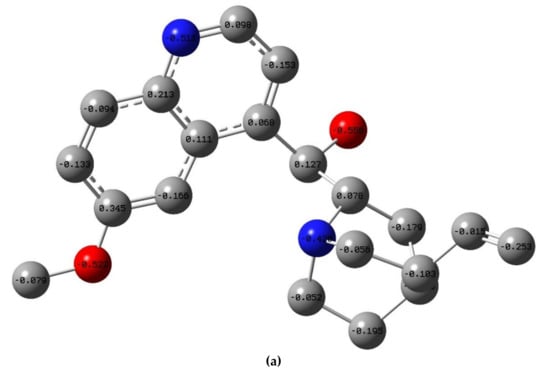
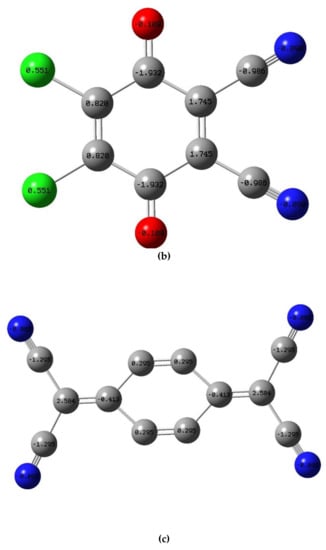
Figure 8.
Mulliken atomic charges of (a) Quinine, (b) DDQ and (c) TNCQ.
Comparing the bond lengths between the free drug, the acceptors and their complexes reveals the lengthening of Quinine bonds of C(10)-N(3), N(3)-C(6) and N(3)-C(11) by 0.023Å, 0.320Å and 0.0180Å at CT formation. In addition, the angle of C(6)-N(3)-C(11) varies by 3.346 Å in the case of Q-DDQ. As for Q-TNCQ, a Q bond lengthening of C(10)-N(3), N(3)-C(6) and N(3)-C(11) by 0.0020, 0.1320 and 0.1830 Å, respectively, is observed along with an angle reduction in C(6)-N(3)-C(11) by 4.437 Å.
Conversely, a decrease of 0.0049 Å and 0.0048Å in the bond length of C(30)-O(31) and C(27)-O(32) is observed in the DDQ moiety following the lengthening of C = O groups and the formation of double bonds. From the previous results and the HOMO-LUMO energy gap values, we conclude that the Q-DDQ and Q-TNCQ complexes belong either to the semiconductor or conductor classes.
A good agreement between experimental values of infrared bands with those calculated theoretically (Tables S2–S4).
It is known that with TD-DFT functional theory [20,28,29], a reliable determination of the UV-Vis absorption spectra is generally possible. The frontier molecular orbital (FMO) energies and descriptions are given in Figure 9. TD-DFT calculations were used to analyze the observed UV-visible spectrum of the Q-DDQ and Q-TNCQ complexes.
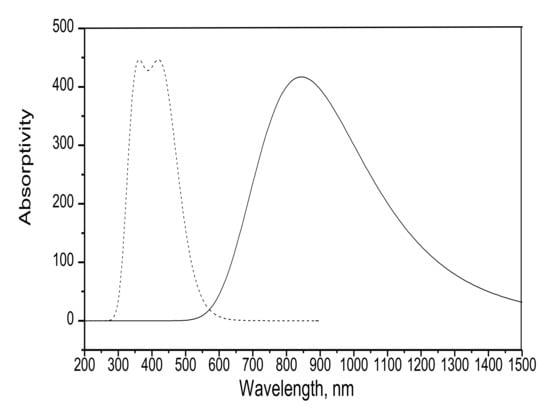
Figure 9.
Theoretical electronic absorption spectra of Q→DDQ (-----) and Q→TCNQ (–––) calculated at TD-B3LYP.
To assign the nature of each electronic transition, the compositions of molecular orbitals are extremely necessary. For example, if the occupied MO is based on the acceptor and the unfilled orbital is based on the donor, the corresponding energy could be assigned to the CT process, while it is known as an internal transition within either the acceptor or the donor system when both the occupied and the virtual orbitals are located on the same moiety. The stimulated TD-B3LYP spectra (Figure 10 and Figure 11) of Q-DDQ and Q-TNCQ complexes compare well with the experimental spectrum. In the case of Q-DDQ, they are characterized by three bands at 431.91 nm (2.87 ev) 412.25 nm (3.015 ev), and 353.26 nm (3.51 ev) corresponding to HOMO→LUMO, HOMO-1→LUMO and HOMO-2→LUMO, respectively. On the other hand, for Q-TNCQ, the spectra are characterized by bands located at 857.06 nm (1.45 ev), 844.68 nm (1.47ev), and 833.93 nm (1.49 ev) nm which correspond to HOMO→LUMO, HOMO→LUMO+1 and HOMO-3→LUMO+1, respectively. Hence, within the drug molecule, the lowest energy band is assigned to the π-π* transition.
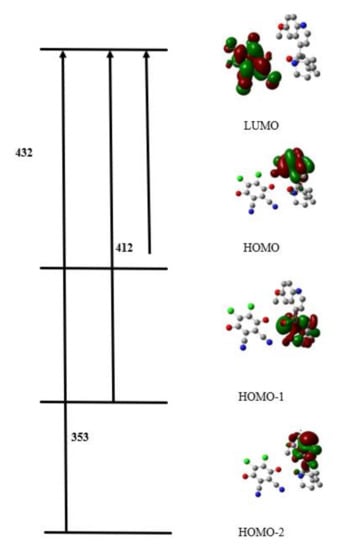
Figure 10.
Assignments of theoretical electronic absorption transitions of Quinine→DDQ charge transfer complexes.
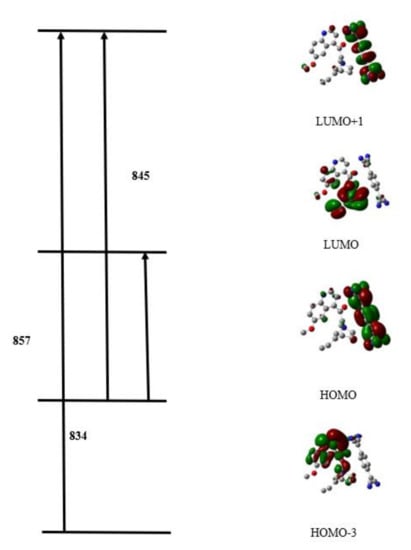
Figure 11.
Assignments of theoretical electronic absorption transitions of Quinine→TNCQ charge transfer complexes.
3.3.2. Molecular Electrostatic Potential
The electrostatic potential surface (EPS) was plotted to test the electronic distribution around quinine (Figure 12). A CT complex is formed when an electrostatic interaction occurs between two oppositely charged pairs, i.e., high and low-density charge regions [29]. In Figure 12 a high electron density is denoted by a red color whereas a low electron density is denoted by blue color. The electron density decreases in the order: red > orange > yellow > green > blue. The diagram shows the potential negative sites that include electronegative atoms as well as the potential positive sites around the hydrogen atoms. The negative charge is centered around the nitrogen atom of the quinoline ring. Such atoms may be responsible for the interaction in hormone receptors by using the hydrogen bond with the active site. It is because this form of bond involves a hydrogen atom in the same or a different molecule that is attracted to a strongly electronegative atom such as oxygen, fluorine, or nitrogen of a polar covalent bond. After the DDQ and TNCQ approach the Quinine, the positive areas are converted into negative (green color), which suggests a CT cycle from the nitrogen atom of the quinoline ring to the acceptor molecule’s π-system.
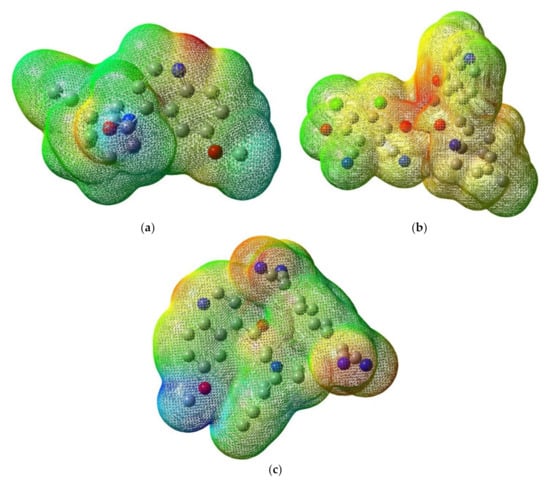
Figure 12.
Molecular electrostatic potential maps of (a) TAM, (b) Quinine→DDQ, and (c) Quinine→TNCQ.
3.3.3. Vibrational Spectral Analysis
The significant frequency vibrations, observed FTIR and vibrational assignments of Quinine, Quinine-DDQ, and Quinine-TNCQ were presented in Tables S2–S4. We noticed that good agreement between observed and calculated frequencies by different theoretical methods calculations.
3.3.4. Quantum Chemical Parameters and Frontier Molecular Orbitals
The highest-occupied molecular orbital (HOMO), which acts as an electron donor, and the lowest unoccupied molecular orbital (LUMO), which acts as an electron acceptor, are both essential factors in quantum chemistry. When the energy gap is small, the molecule is highly polarizable and has a high chemical reactivity. EHOMO and ELUMO in Table 6 explain the inevitable charge-exchange collaboration inside the investigated molecule. The inevitable charge-exchange collaboration within the studied compound is clarified by EHOMO and ELUMO, in Table 6. Electronegativity (χ), chemical potential (μ), global hardness (η), global softness (S), global Electrophilicity index (ω), and softness (σ) are recorded and calculated by Equations (1)–(6). It is observed that the Lewis base Quinine drug was flexible towards the DDQ and TNCQ (Lewis acid) with significant softness values. The negative electronic chemical potential (−3.42 ev) and positive electrophilicity index (ω = 2.73 ev) enable the Quinine to capture electrons from its surroundings. The Quinine exhibits the highest energy gap (4.28 ev) on complexation; the energy barrier gets reduced; hence all of them possess a higher softness value than Quinine. High dipole moment values on complexes indicate the effective binding with the Quinine molecule. From Table S4 we noticed that in Quinine-TNCQ there is a big jump of the value of ELUMO to −5.36 ev and become more near to EHOMO (−7.58 ev) which facilate charge transfer of electrons and so energy gap become lower than that of Quinine only. In case of Quinine-DDQ a small jump of ELUMO value to −2.67 ev but also become near to EHOMO (−5.94 ev) and also small energy gap in comparison with Quinine only. The high jump value of ELUMO in case of Quinine-TNCQ may explain the position of LUMO on Quinine in case of Quinine-TNCQ while HOMO on TNCQ.

Table 6.
Calculated Energies of Quinine, Quinine-DDQ, and Quinine-TNCQ.
Χ = −1/2 (ELUMO + EHOMO)
µ = −χ = 1/2 (ELUMO + EHOMO)
η = 1/2 (ELUMO − EHOMO)
S = 1/2 η
ω = µ2/2 η
The inverse value of the global hardness is designed as the softness (σ) as follow:
σ = 1/η
3.3.5. Fukui Indices Analysis
The Fukui functions of Quinine for the atomic site were calculated (Table S6). The N7 atom on Quinine is the preferential electrophilic attacking site. In case of DDQ O7, and O8 atoms while C2 and C5 in case of TNCQ are the preferential nucleophilic attacking sites (Tables S5–S7). Through the previous results, we can explain the occurrence of the transfer of charges through these atoms. This is another confirmation through theoretical studies.
4. Conclusions
The formation of quinine CT complexes with DDQ and TCNQ has been studied. The characterization of Q-CT complexes was investigated in solution using spectrophotometry. Job’s method was used to calculate the molar ratio and the results was agreed with the Benesi-Hildebrand method (1:1 ratio). The characterization of the formed complexes was carried out by studying the spectroscopic parameters e.g., oscillator strength, transition dipole moment, ionization potential, the energy of CT complex, resonance energy, dissociation energy… etc were estimated. The results confirmed the formation of the formed Q-CT complexes with high stability. On the other hand, the synthesized Q-CT complexes were investigated and confirmed using FTIR, NMR and conductometry.
Quantum chemical calculations (optimization and MEP maps) were presented at the theory level of DFT/B3LYP to give a deeper insight into H-bond interactions, hybridization, and CT charging distributions. The results obtained using theoretical calculation methods allowed us to determine several molecular properties of the studied CT complex components. A comparison was presented between the experimental results and those calculated by the different theoretical methods from both donor and acceptor. The two sets of results were shown to be similar both structurally and electronically.
In summary, due to the simplicity of the preparation and various application of CT complexes, our method will be opened a new door to develop such study of researcher over the world.
Supplementary Materials
The following supporting information can be downloaded at: https://www.mdpi.com/article/10.3390/app12030978/s1, Figure S1. FTIR spectrum of quinine; Figure S2. FTIR spectrum of DDQ; Figure S3. FTIR spectrum of TCNQ; Figure S4. The 1H NMR spectrum of quinine in acetone-d6; Table S1. Mulliken charge of DDQ, TCNQ, Q-DDQ and Q-TCNQ; Table S2. Observed IR frequencies, calculated IR frequencies, and probable vibrational assignments of quinine with scaling value 0.96; Table S3. Observed IR frequencies, calculated IR frequencies, and probable vibrational assignments of qui-nine-DDQ CT complex with scaling value 0.96; Table S4. Observed IR frequencies, calculated IR frequencies, and probable vibrational assignments of qui-nine-TCNQ CT-complex with scaling value 0.96; Table S5. Fukui indices analysis of Quinine; Table S6. Fukui indices analysis of DDQ; Table S7. Fukui indices analysis of TCNQ.
Author Contributions
Visualization and formal analysis A.M.H. and R.A.-S.; Methodology and writing—review and editing, H.I.A., Computational study T.A.Y.; Synthesis and characterization S.T.G.; Methodology, validation and writing-original draft., G.A.E.M. and H.A.; All authors have read and agreed to the published version of the manuscript.
Funding
This research was funded by the Deanship of Scientific Research at King Saud University for funding the work through Research Group Project No. RG-1438-045.
Institutional Review Board Statement
Not applicable.
Informed Consent Statement
Not applicable.
Data Availability Statement
All data resulted from this study was presented in the manuscript and supplementary material.
Acknowledgments
The authors extend their appreciation to the Deanship of Scientific Research at King Saud University for funding the work through Research Group Project No. RG-1438-045.
Conflicts of Interest
The authors declare that no conflict of interest associated with this study.
References
- Mulliken, R.S. Structures of Complexes Formed by Halogen Molecules with Aromatic and with Oxygenated Solvents1. J. Am. Chem. Soc. 1950, 72, 600–608. [Google Scholar] [CrossRef]
- Mulliken, R.S. Molecular Compounds and their Spectra. III. The Interaction of Electron Donors and Acceptors. J. Phys. Chem. 1952, 56, 801–822. [Google Scholar] [CrossRef]
- Refat, M.S.; El-Sayed, M.Y.; Adam, A.M.; Saad, H.A.; Eldaroti, H.H. Charge transfer complexes as a semiconductor models: Outline of spectroscopic studies on electron donor-acceptor complexes of hexane-1, 6-diol with different π-acceptors. Int. J. Electrochem. Sci. 2013, 8, 4234–4259. [Google Scholar]
- AlQaradawi, S.Y.; Mostafa, A.; Bengali, A.A. Charge-transfer complexes formed in the reaction of 2-amino-4-ethylpyridine with π-electron acceptors. J. Mol. Struct. 2016, 1106, 10–18. [Google Scholar] [CrossRef]
- Wu, L.; Wu, F.; Sun, Q.; Shi, J.; Xie, A.; Zhu, X.; Dong, W. A TTF–TCNQ complex: An organic charge-transfer system with extraordinary electromagnetic response behavior. J. Mater. Chem. C 2021, 9, 3316–3323. [Google Scholar] [CrossRef]
- Darwish, I.A.; Khalil, N.Y.; Alsaif, N.A.; Herqash, R.N.; Sayed, A.Y.; Abdel-Rahman, H.M. Charge-Transfer Complex of Linifanib with 2,3-dichloro-3,5-dicyano-1,4-benzoquinone: Synthesis, Spectroscopic Characterization, Computational Molecular Modelling and Application in the Development of Novel 96-microwell Spectrophotometric Assay. Drug Des. Dev. Ther. 2021, ume 15, 1167–1180. [Google Scholar] [CrossRef]
- Adam, A.M.A.; Refat, M.S. A comparison of charge-transfer complexes of iodine with some antibiotics formed through two different approaches (liquid-liquid vs solid-solid). J. Mol. Liq. 2021, 329, 115560. [Google Scholar] [CrossRef]
- Spectroscopy and Structure of Molecular Complexes; Yarwood, J. (Ed.) Springer: Boston, MA, USA, 1973; pp. 1–594. [Google Scholar]
- Basha, M.T.; Alghanmi, R.M.; Soliman, S.M.; Alharby, W.J. Synthesis, spectroscopic, thermal, structural characterization and DFT/TD-DFT computational studies for charge transfer complexes of 2, 4-diamino pyrimidine with some benzoquinone acceptors. J. Mol. Liq. 2020, 309, 113210. [Google Scholar] [CrossRef]
- Soltani, S.; Magri, P.; Rogalski, M.; Kadri, M. Charge-transfer complexes of hypoglycemic sulfonamide with π-acceptors: Experimental and DFT-TDDFT studies. J. Mol. Struct. 2018, 1175, 105–116. [Google Scholar] [CrossRef]
- Abdallah, A.M.; Frag, E.Y.; Tamam, R.H.; Mohamed, G.G. Gliclazide charge transfer complexes with some ben-zoquinone acceptors: Synthesis, structural characterization, thermal analyses, DFT studies, evaluation of anticancer ac-tivity and utility for determination of gliclazide in pure and dosage forms. J. Mol. Struct. 2021, 1234, 130153. [Google Scholar] [CrossRef]
- Madrahimov, S.; Mostafa, A.; Yempally, V.; Fadlallah, J.; AlQaradawi, S.Y. Electronic, infrared, mass spectrometry and thermal studies on the reaction of 2-amino-6-methylpyridine with π-acceptors. J. Mol. Struct. 2020, 1199, 127021. [Google Scholar] [CrossRef]
- Mohamed, M.E.; Frag, E.Y.; Hathoot, A.A.; Shalaby, E.A. Spectrophotometric determination of fenoprofen calcium drug in pure and pharmaceutical preparations. Spectroscopic characterization of the charge transfer solid complexes. Spectrochim. Acta Part A Mol. Biomol. Spectrosc. 2018, 189, 357–365. [Google Scholar] [CrossRef] [PubMed]
- Alam, K.; Khan, I.M. Crystallographic, dynamic and Hirshfeld surface studies of charge transfer complex of imidazole as a donor with 3,5-dinitrobenzoic acid as an acceptor: Determination of various physical parameters. Org. Electron. 2018, 63, 7–22. [Google Scholar] [CrossRef]
- Takahashi, K.; Horino, K.; Komura, T.; Murata, K. Photovoltaic Properties of Porphyrin Thin Films Mixed with o-Chloranil. Bull. Chem. Soc. Jpn. 1993, 66, 733–738. [Google Scholar] [CrossRef]
- Datta, A.S.; Chattaraj, S.B.; Chakrabortty, A.; Lahiri, S.C. Studies on the weak interactions and CT complex formations between chloranilic acid, 2,3-dichloro-5,6-dicyano-p-benzoquinone, tetracyanoethylene and papaverine in acetonitrile and their thermodynamic properties, theoretically, spectrophotometrically aided by FTIR. Spectrochim. Acta Part A Mol. Biomol. Spectrosc. 2015, 146, 119–128. [Google Scholar] [CrossRef]
- Khan, I.M.; Alam, K.; Alam, M.J. Exploring charge transfer dynamics and photocatalytic behavior of designed donor-acceptor complex: Characterization, spectrophotometric and theoretical studies (DFT/TD-DFT). J. Mol. Liqu. 2020, 310, 113213. [Google Scholar] [CrossRef]
- Adam, A.M.; Saad, H.A.; Alsuhaibani, A.M.; Refat, M.S.; Hegab, M.S. Charge-transfer chemistry of azithromycin, the antibiotic used worldwide to treat the coronavirus disease (COVID-19). Part II: Complexation with several π-acceptors (PA, CLA, CHL). J. Mol. Liqu. 2021, 325, 115121. [Google Scholar] [CrossRef]
- Adam, A.M.A.; Eldaroti, H.H.; Hegab, M.S.; Refat, M.S.; Al-Humaidi, J.Y.; Saad, H.A. Measurements and correlations in solution-state for charge transfer products caused from the 1:2 complexation of TCNE acceptor with several important drugs. Spectrochim. Acta Part A Mol. Biomol. Spectrosc. 2018, 211, 166–177. [Google Scholar] [CrossRef]
- Gross, E.K.; Dobson, J.F.; Petersilka, M. Density functional theory of time-dependent phenomena. In Density Functional Theory II; Springer: Berlin/Heidelberg, Germany, 1996; pp. 81–172. [Google Scholar]
- Job, P. Advanced physicochemical experiments. Edinburgh: Oliner and Boyd. Ann. Chem. 1964, 1963, 97. [Google Scholar]
- Foster, R. Organic Charge-Transfer Complexes; Academic Press: London, UK, 1969; pp. 51–387. [Google Scholar]
- Benesi, H.A.; Hildebrand, J.H.J. A spectrophotometric investigation of the interaction of iodine with aromatic hydro-carbons. J. Am. Chem. Soc. 1949, 71, 2703–2707. [Google Scholar] [CrossRef]
- Aloisi, G.G.; Pignataro, S. Molecular complexes of substituted thiophens with σ and π acceptors. Charge transfer spectra and ionization potentials of the donors. J. Chem. Soc. 1973, 69, 534–539. [Google Scholar] [CrossRef]
- Briegleb, G.; Czekalla, J. Electron transfer by light absorption and emission in electron donor-acceptor complexes. Angew. Chem. 1960, 72, 401–413. [Google Scholar] [CrossRef]
- Bürgi, T.; Baiker, A. Conformational Behavior of Cinchonidine in Different Solvents: A Combined NMR and ab Initio Investigation. J. Am. Chem. Soc. 1998, 120, 12920–12926. [Google Scholar] [CrossRef]
- Sen, A.; Bouchet, A.; Lepère, V.; Barbu-Debus, K.; Scuderi, D.; Piuzzi, F.; Zehnacker-Rentien, A. Conformational Analysis of Quinine and Its Pseudo Enantiomer Quinidine: A Combined Jet-Cooled Spectroscopy and Vibrational Circular Di-chroism Study. J. Phys. Chem. A 2012, 116, 8334–8344. [Google Scholar] [CrossRef]
- Casida, M.E. Recent Advances in Density Functional Methods. In Time-Dependent Density Functional Response Theory for Molecules, Part I; Chong, D.P., Ed.; World Scientific: Singapore, 1995; pp. 155–192. [Google Scholar]
- Yousef, T.A.; Ezzeldin, E.; Abdel-Aziz, H.A.; Al-Agamy, M.H.; Mostafa, G.A. Charge Transfer Complex of Neostigmine with 2,3-Dichloro-5,6-Dicyano-1,4-Benzoquinone: Synthesis, Spectroscopic Characterization, Antimicrobial Activity, and Theoretical Study. Drug Des. Dev. Ther. 2020, ume 14, 4115–4129. [Google Scholar] [CrossRef]
Publisher’s Note: MDPI stays neutral with regard to jurisdictional claims in published maps and institutional affiliations. |
© 2022 by the authors. Licensee MDPI, Basel, Switzerland. This article is an open access article distributed under the terms and conditions of the Creative Commons Attribution (CC BY) license (https://creativecommons.org/licenses/by/4.0/).